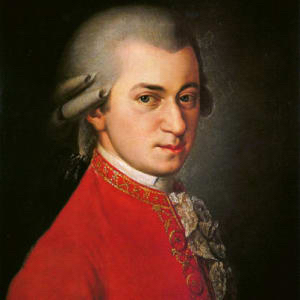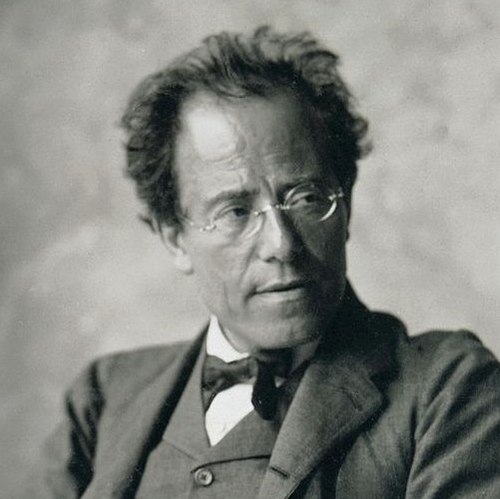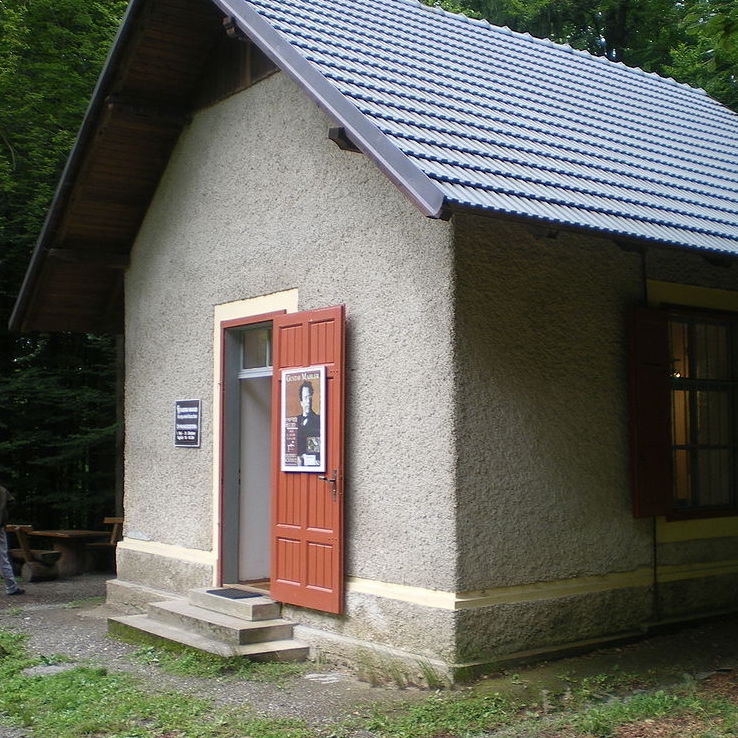Madison Symphony
Orchestra Program Notes
January 19-20-21, 2024
98th Season / Subscription Program 5
J. Michael Allsen
To open this
program, we welcome back pianist Joyce Yang. Ms. Yang
previously appeared with Madison Symphony Orchestra in
2019, with a memorable performance of Prokofiev’s third
piano concerto. At these concerts she performs Mozart’s
Piano Concerto No.
24, among his most tense and serious works for
solo piano. We
then turn to the vast Symphony No. 5
by Gustav Mahler, a work the composer identified as a
new phase in his development.
 This
uncharacteristically serious work was one of three piano
concertos Mozart composed at the same time he was
working on his opera The Marriage of
Figaro.
This
uncharacteristically serious work was one of three piano
concertos Mozart composed at the same time he was
working on his opera The Marriage of
Figaro.
Wolfgang
Amadeus Mozart
Born:
January 27, 1756, Salzburg, Austria.
Died:
December 5, 1791, Vienna, Austria.
Concerto No. 24 in
C minor for Piano and Orchestra, K. 491
•
Composed:
Completed March 24, 1786.
• Premiere: The
composer probably played and conducted the first
performance in a concert at Vienna’s Burgtheatre on April
7, 1786.
•
Previous
MSO Performance: 1984, with pianist Charles Rosen.
•
Duration:
23:00.
Background
Fifteen of
Mozart’s twenty-seven piano concertos, including No. 24, were
written for his public concerts in Vienna. These concerts
were a major factor in establishing himself in the
imperial capital.
Mozart’s
reputation and success in his early years in Vienna came
largely through his private recitals, and public
“subscription” performances of his own works. Viennese
audiences demanded new concertos at every concert, and
Mozart responded with an amazing series of fifteen
concertos written during his first five years in Vienna.
The winter of 1785-86 was a particularly busy time: his
main concern was the opera The Marriage of Figaro, which would premiere
in Vienna in May 1786, but he was obliged to take time in
February to dash off a one-act Singspiel, The Impresario,
for a commission by the Emperor. He also managed
to find time to complete three piano concertos: No. 22 in
December, No. 23
on March 2, and No.
24 just three weeks later on March 24. The bulk of
Viennese public concerts occurred during the Christmas
season and Lent, and No. 22 was played on December 26. Mozart had at
least three subscription concerts that spring, and the
other two concertos were probably performed at these. One
innovation he introduced in these three concertos was a
pair of clarinets, substituting for the usual oboes in the
first two, and as part of a relatively large scoring in No. 24. He was inspired
by his friendship with the clarinetist Anton Stadler, and
he used clarinets prominently in Figaro as well.
What You’ll Hear
This work is in
three movements:
• A broad opening
movement set in sonata form.
• A Larghetto, with a
lyrical main theme and two contrasting episodes.
• A set of
variations on a march-style theme.
The Piano Concerto No. 24
is the largest of the three concertos, and certainly the
most serious in tone: it is one of only two piano
concertos he cast in a minor key. The opening Allegro begins
with a stern orchestral exposition that presents a rich
array of material for the movement, alternating between a
threatening main theme (sounding very much like the
introduction to a tragic opera) and flowing woodwind
passages. When the piano enters, it is with an entirely
new idea, lyrical and melancholy, before the orchestra
announces the main theme and the solo part begins a
decorated version of the exposition. The extensive
development section begins with a return to the piano’s
initial music and then works primarily with the main
theme. Following an abbreviated recapitulation, Mozart
leaves space for a solo cadenza, before ending in a stormy
coda.
The Larghetto is a
complete change in mood, beginning with a main idea from
the piano in luminous E-flat Major. This idea alternates
with a pair of contrasting episodes, both of them led by
the woodwinds: the first pensive and the second more
pastoral. The final statement of the main theme is
interrupted briefly for a short cadenza. The closing
movement (Allegretto)
presents a set of six variations on a marchlike theme
introduced by the orchestra.
After three increasingly intense variations, the
fourth variation is suddenly in a pastoral major key, led
by the woodwinds. A more agitated variation by the solo
piano follows, and the sixth variation transforms the
theme into much happier music in C Major. Mozart returns
firmly to C minor at the end, setting up a final solo
cadenza. This leads directly into the coda, based upon an
entirely new idea set in 6/8.
 In describing his fifth symphony, Mahler
referred to it as a work in a “completely new style.” This
colossal work breaks with his earlier symphonies: there is
no program and no reliance on vocal music, but instead a
starker and more intellectual approach.
In describing his fifth symphony, Mahler
referred to it as a work in a “completely new style.” This
colossal work breaks with his earlier symphonies: there is
no program and no reliance on vocal music, but instead a
starker and more intellectual approach.
Gustav Mahler
Born: July 7,
1860, Kalischte, Bohemia.
Died: May 18,
1911, Vienna, Austria.
Symphony No. 5 in
C-sharp minor
• Composed:
1901-1902. He continued to revise the score over the next
several years.
•
Premiere:
October 18, 1904 in Cologne, conducted by the composer.
•
Previous
MSO Performances: 1982 and 1998.
•
Duration:
69:00.
Background
This work was
composed at the time of Mahler’s marriage to Alma
Schindler and other momentous changes in his career. Due
to his conducting schedule, the time and solitude he
needed to compose was available only in during summer
holidays. The
Symphony No. 5
was completed in the summers of 1901 and 1902.
1901 was one
of the most significant years of Mahler’s life. He acquired
property at Mayernigg, near Lake Wörther in southern
Austria: the beloved summer retreat where most of his late
works were composed.
There were professional changes as well: early that
year, health problems, apparently caused by overwork,
forced him to step down as conductor of the Vienna
Philharmonic. (From
all accounts, the musicians of this democratically-run
orchestra had long chafed under Mahler’s authoritarian
style. During his absence, they quickly elected another
conductor, even before Mahler had a chance to resign
officially!) However,
the most important event of 1901 was meeting Alma
Schindler at a dinner party.
Mahler was instantly attracted to this brilliant
and beautiful 20-year-old, who was a composer in her own
right. For
her part, Alma Schindler was just a bit awed by the
conductor and composer, who was twice her age. A romance
blossomed quickly, and they were married on March 2, 1902. Marriage was a
very good thing for Gustav, though Alma’s musical career
was cut short at his insistence: she was to be his partner
in most things, but there was apparently room for only one
composer in the family.
Alma was able to take care of the day-to-day
details of housekeeping and business that he found so
irritating, leaving him freer to compose.
Composition
was almost exclusively limited to summer holidays, and the
time Mahler spent at Mayernigg was jealously guarded. According to
Alma’s diary, he maintained a strict regime. He rose at dawn
and tromped up to his “composition cottage” in the woods—a
small shed that contained little besides a desk and a
piano. His
breakfast was brought up by a maid, who according to Alma,
was terrified of Mahler, and would leave the tray and run. He would work in
solitude all morning, and after lunch would hike or row
with Alma. Even
during the afternoons and evenings, he would be working on
compositional problems, and would suddenly break away from
guests or other activities to work for hours at a time. The Symphony No. 5
was composed during two of these holidays, in 1901 and
1902.
The "composition cottage" at Mayernigg
 This work, which Mahler originally
nicknamed the “giant symphony,” was essentially complete
in 1902, but was to be revised extensively several times. After a
preliminary sight-reading in 1904, he deleted many of the
percussion parts that were prominent in the first version. (Alma writes in
her diary of “sobbing aloud” when she heard the percussion
drowning out the rest of the orchestra.) Though the
premiere went well later that year, he made significant
changes before conducting the work in Amsterdam in 1906,
and revised it yet again for a performance in 1908. It was not until
shortly before his death—and after completing four more
symphonies—that Mahler wrote to a friend: “I have finished
the Fifth. I
actually had to reorchestrate it completely. I don’t
understand how I could have gone so completely astray—just
like a beginner. Evidently
the routines I had established with the first four
symphonies were entirely inadequate for this one—for a
completely new style demands a new technique.”
This work, which Mahler originally
nicknamed the “giant symphony,” was essentially complete
in 1902, but was to be revised extensively several times. After a
preliminary sight-reading in 1904, he deleted many of the
percussion parts that were prominent in the first version. (Alma writes in
her diary of “sobbing aloud” when she heard the percussion
drowning out the rest of the orchestra.) Though the
premiere went well later that year, he made significant
changes before conducting the work in Amsterdam in 1906,
and revised it yet again for a performance in 1908. It was not until
shortly before his death—and after completing four more
symphonies—that Mahler wrote to a friend: “I have finished
the Fifth. I
actually had to reorchestrate it completely. I don’t
understand how I could have gone so completely astray—just
like a beginner. Evidently
the routines I had established with the first four
symphonies were entirely inadequate for this one—for a
completely new style demands a new technique.”
This
“completely new style” represents a break with what he had
done in the first four symphonies. Despite their variety
in style, all of these were programmatic: having a clear
storyline or meaning. All of them are also based in some
way upon Mahler’s musical settings of the folk-style poems
from Des Knaben
Wunderhorn (The
Boy’s Magic Horn).
In the Symphony
No.5, Mahler rejects the idea of an extramusical
program, and breaks with the use of vocal music and text
that had been so much a part of the second, third, and
fourth symphonies. The
symphony also makes a musical break with his previous
works. It was
during this period that Mahler began to study the works of
J. S. Bach. (The
only printed music in Mahler’s “composition cottage” at
Mayernigg was a prized set of the Bach Complete Works.) A newer, more
intellectual contrapuntal style is heard in this symphony.
What You’ll Hear
The symphony is
laid out in five large movements:
• A stern
“funeral march,” beginning with a trumpet fanfare. Mahler
intended this to serve as an extended introduction to the
second movement.
• A
ferocious second movement in a loose sonata form that
builds towards a titanic brass chorale.
• An enormous
scherzo organized around a series of Austrian-style dance
tunes, and a darker contrasting trio.
• A serene Adagietto, scored
for strings and harp. This leads directly into the finale.
• The Rondo-Finale,
which again uses a dance tune as a main theme, in a
movement that features dense contrapuntal writing,
The Symphony No.5 is
set in five movements, which Mahler organizes into three
parts: the funeral march and second movement constitute
Part I, Part II consists of the gargantuan Scherzo, and Part
III includes the Adagietto
and Rondo-Finale. The symphony
begins with a solemn fanfare from a solo trumpet—this
rhythm pervades much of the movement’s music. Mahler
titles the movement Trauermusik (funeral music) and gives the
direction In
gemessen Schritt, streng, wie ein Konduit (In
measured step, stern, as in a funeral procession). The
opening fanfare leads into a somber march for brass, and a
sad string melody. The
trumpet fanfare appears again, and there is an almost
violent middle passage that breaks the solemn march and
moves towards an angry climax. Once again, the
trumpet interjects, and there is a long concluding passage
that returns to the defeated tread of the opening march. The movement
dies away quietly and gradually.
Mahler
considered the funeral march to be an introduction to the
second movement, marked Stürmische bewegt,
mit grösster Vehemenz (Stormily agitated, with
greatest vehemence), which begins without a pause. The movement,
set in a greatly expanded sonata form, begins with a
furious figure in the basses that the brasses answer with
equal rage. The mood breaks suddenly, and the cellos play
a sad tune that recalls the march of the first movement. The development
begins with a recitative-style line for the cellos that
Mahler marks Klagend
(“grieving”). This
section builds gradually through restatements and
recombinations of his themes, over a vast stretch of
musical time, before culminating in a titanic brass
chorale—Mahler marks this moment in the score Höhepunkt
(high-point or climax—as if we could fail to notice!) When
the opening theme returns, it is almost an afterthought to
this moment—it builds towards a second peak, but then
subsides to fade away to nothing. Mahler specifies
a long break after the close of this movement.
The title Scherzo (Italian
for “joke”) usually implies a light, sometimes humorous,
fast-paced movement. While there is certainly humor to be
found in this movement, it is no lightweight—at over 800
measures, it is the longest section of the symphony. Mahler wrote to
Alma while he was rehearsing for the premiere, describing
it as
“the devil of a movement. I see it is in
for a lot of trouble.
Conductors for the next fifty years will all take
it too fast, and make nonsense of it; and the public—what
are they to make of this chaos of which new worlds are
forever being engendered, only to crumble in into ruin the
moment after. What are they to say to this primeval music,
this foaming, roaring, raging sea of flashing breakers? Oh that I might
give my symphony its first performance fifty years after
my death!”
The main
theme is stated by all four horns, and the opening panel
is series of several dance melodies—mostly in the
rough-edged character of the Austrian country laendler,
but occasionally lapsing into a citified waltz. The lengthy trio
uses a more reflective idea stated by solo horn, which is
then developed. Just
when everything seems to be dwindling to a close, the
strings begin an upbeat Laendler tune and sweep the rest
of the orchestra towards a climax (listen for a prominent
woodblock solo). The
horns enter again and there is a varied restatement of the
opening material, with dense contrapuntal elaboration. The coda turns
briefly to the darker mood of the trio, before ending
abruptly with a final horn fanfare: a formal trick Mahler
certainly learned from the Scherzo movements
of his hero, Beethoven.
Part III of
the symphony begins with the dreamy Adagietto. This
movement, scored simply for strings and harp, is dwarfed
by the movements that surround it, and shows Mahler’s more
introspective side. It
is based upon two long melodies sung by strings, and
mounts to a subdued peak and then fades away. As in Part I,
there is no break between this movement and the next.
The Rondo-Finale
begins with a wonderful passage in which sustained tones
from the horn are answered by solo woodwinds. This leads
to a Austrian country-band passage that serves as the
refrain in this movement.
The refrain closes as the cellos begin vigorously
laying out an agitated line that becomes the subject of an
extended fugue. The
refrain returns again, and another contrapuntal episode
begins, eventually moving towards a new version of the Adagietto’s main
melody. This
becomes a theme for a series of loosely-structured
variations, as the movement works inexorably towards a Höhepunkt—again,
a triumphal brass chorale, now decorated by the strings
and woodwinds playing the fugue subject. There is little
that remains unsaid at this point, and the movement comes
quickly to a close.
________
program notes ©2023 by J. Michael
Allsen